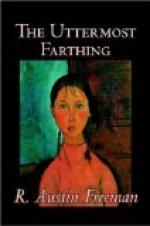I cannot answer the question. Perhaps a further study of his Archives may throw some fresh light on it.
III
THE HOUSEMAID’S FOLLOWERS
The contrast in effect between suspicion and certainty is very curious to observe. When I had walked through the private museum of my poor friend Challoner and had looked at the large collection of human skeletons that it contained, a suspicion that there was something queer about those skeletons had made me quite uncomfortable. Now, after reading his first narrative, I knew all about them. They were the relics of criminals whom he had taken red-handed and preserved for the instruction of posterity. Thus were my utmost suspicions verified, and yet, strange as it may seem, with the advent of certainty, my horror of them vanished. Even the hideous little doll-like heads induced but a passing shudder. Vague, half superstitious awe gave place to scientific interest.
I took an early opportunity of renewing my acquaintance with the astonishing and gruesome “Museum Archives.” The second narrative was headed “Anthropological Series, 2, 3 and 4.” It exhibited the same singular outlook as the first, showing that to Challoner the criminal had not appeared to be a human being at all, but merely a sub-human form, anatomically similar to man.
“The acquisition of Specimen Number One,” it began, “gave me considerable occupation, both bodily and mental. As I labored from day to day rendering the osseous framework of the late James Archer fit for exhibition in a museum case, I reflected on the future to which recent events had committed me. I had been, as it were, swept away on the tide of circumstance. The death of this person had occurred by an inadvertence, and accident had thrown on me the onus of disposing of the remains. I had solved that difficulty by converting the deceased into a museum specimen. So far, well, but what of the future?
“My wife had been murdered by a criminal. The remainder of my life—short, I hoped—was to be spent in seeking that criminal. But the trap that I set to catch him would probably catch other criminals first; and since the available method of identification could not be applied to newly-acquired specimens while in the living state, it followed that each would have to be reduced to the condition in which identification would be possible. And if, on inspection, the specimen acquired proved to be not the one sought, I should have to add it to the collection and rebait the trap. That was evidently the only possible plan.
“But before embarking on it I had to consider its ethical bearings. Of the legal position there was no question. It was quite illegal. But that signified nothing. There are recent human skeletons in the Natural History Museum; every art school in the country has one and so have many board schools. What is the legal position of the owners of those human remains? It will not bear investigation. As to the Hunterian Museum, it is a mere resurrectionist’s legacy. That the skeleton of O’Brian was obtained by flagrant body-snatching is a well-known historical fact, but one at which the law, very properly, winks. Obviously the legal position was not worth considering.




